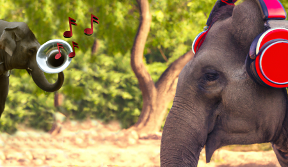This project investigates the design of systems that offer zoo-housed elephants some control over their auditory environment in the form of acoustic instruments they can choose to play with.
Elephants are highly social animals who normally live in large herds and communicate regularly with each other using acoustic, chemical, tactile and visual signals. They can hear and produce low-frequency audio waves (infrasound), allowing them to perceive signals from far away. In managed environments, elephants are unlikely to be part of large extended families due to limited space, so their auditory stimulation may be more limited.
Humans have played various types of music and other sounds to elephants, hoping to elicit positive responses. These have met with limited success, which is unsurprising because human music is designed by humans for human ears. Our auditory system has evolved to facilitate perception in a human context, while elephants have evolved a different audible spectrum and are sensitive to different types of signals.

Image: Dall-E generated an image showing an Asian elephant wearing large red headphones in a natural environment.
Project team
External Partners
- Blair Drummond Safari Park: Mondi, African female elephant.
- Skanda Vale Ashram: Valli and Lakshmi, Asian female elephants.
- Noah’s Ark Zoo: Janu, Shaka and Sutton, African male elephants.
More about the project
Elephants are highly social animals who normally live in large herds and communicate regularly with each other using acoustic, chemical, tactile and visual signals. They can hear and produce low-frequency audio waves (infrasound), allowing them to perceive signals from far away. In managed environments, elephants are unlikely to be part of large extended families due to limited space, so their auditory stimulation may be more limited.
Humans have played various types of music and other sounds to elephants, hoping to elicit positive responses. These have met with limited success, which is unsurprising because human music is designed by humans for human ears. Our auditory system has evolved to facilitate perception in a human context, while elephants have evolved a different audible spectrum and are sensitive to different types of signals.
A musical instrument for an elephant would need to be able to produce the kinds of sounds that elephants like to hear and to have an interface that could be controlled using a trunk (for example). This is our challenge!
As a first step, we are using Audiomoths to monitor low-frequency acoustic signals performed by zoo and sanctuary-housed elephants during different times of the day, as well as any environmental infrasound around their enclosures. At the same time, we are investigating the synthesis and production of low-frequency audio.
We still don’t really understand why it exists or if it is a uniquely human phenomenon. Music is surprisingly complex for the brain to understand because it requires significant cognitive processing to analyse individual sounds dynamically and reinterpret them as a holistic experience. Our bodies respond to music by releasing neurotransmitters, including dopamine (which makes us alert and motivated), serotonin (responsible for feelings of happiness and well-being) and norepinephrine (causing elation and euphoria). In other words, music triggers the pleasure and reward centres in the brain, which is what makes it so engaging for humans. Is it conceivable any of these neurological responses could be present in other animals listening to their own forms of music?
A musical instrument for an elephant would need to be able to produce the kinds of sounds that elephants like to hear and to have an interface that could be controlled using a trunk. This is our challenge!



